Angela Slatter's Blog, page 39
June 25, 2017
Corpselight: for real copies!
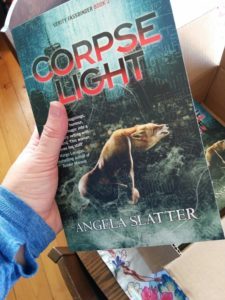 These just arrived! Happy dance.
These just arrived! Happy dance.
Also important was the arrival of the coffee. 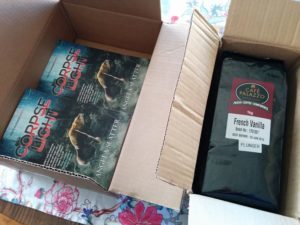
June 23, 2017
Secret Project, Ssssssshhhh
You won’t tell anyone will you?
I’m just going over the artwork for a secret project with Kathleen Jennings, just a tiny one. Details to come …
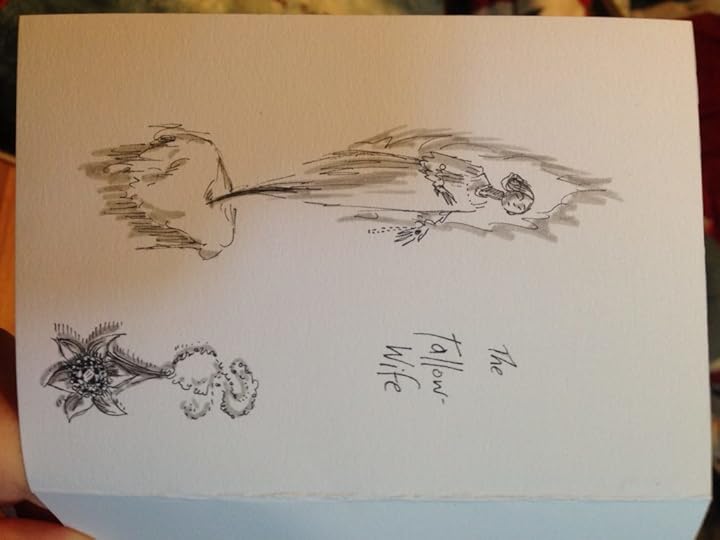
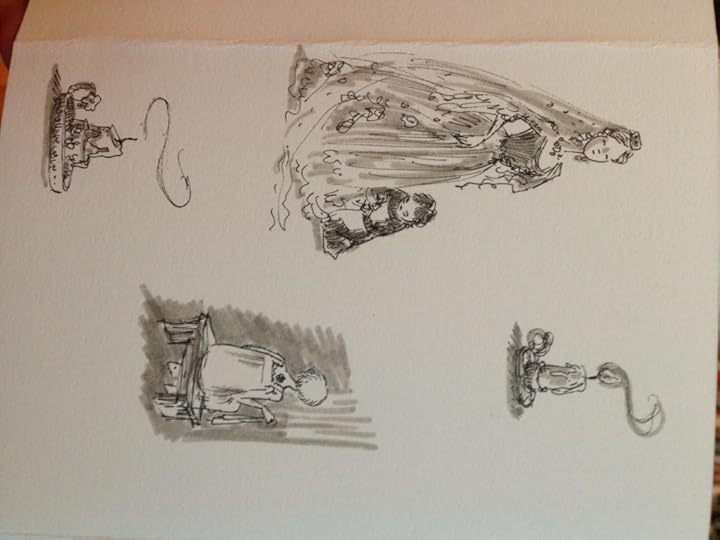
June 21, 2017
I’m Not Crying, YOU’RE Crying!
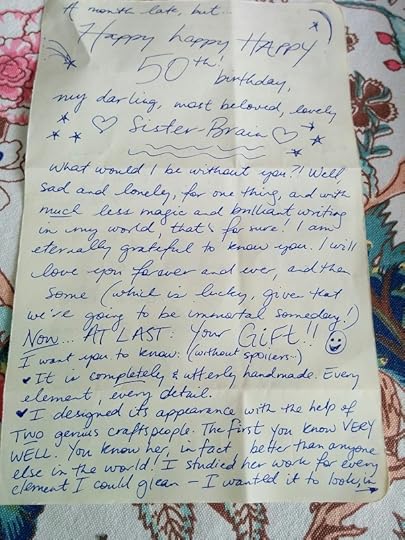 I just opened my birthday present from my Best Brain, Sister-Brain, Frequent Collaborator and Conspirator, Lisa L. Hannett.
I just opened my birthday present from my Best Brain, Sister-Brain, Frequent Collaborator and Conspirator, Lisa L. Hannett.
Sure, it’s a month late, but Best Brains care not for such trivialities of time and space, for we are Immortal (or have detailed plans in train to be so). Also, because when your best friend says “I’m having something made for you!” you just fecking wait patiently. When said present arrived in a bulky parcel, I texted “It’s here” and we face-timed while I opened it. Everybody does that, right?
So, anyway, while Lisa hyperventilated in her car outside the gym in Adelaide, I tore that parcel limb from limb in Brisneyland. Then made a sound which, in retrospect, was probably something like a cow dying. Lisa’s face clearly flickered to “OMFG she’s hates it! She haaaaates it, Precioussssss!”
But no, dear reader, for I did love it. I did love it so much that I lost every skerrick of dignity I possess and made a noise like a cow dying. And what is this magnificent object? I’m glad you asked, but you have to do what I had to do and read the letter first.
Go on, I’ll wait. I’ll put the kettle on.
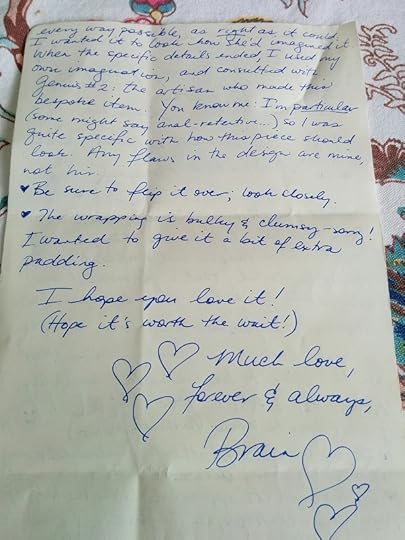
Right, done?
Excellent, you read very quickly, well done you.
It was this: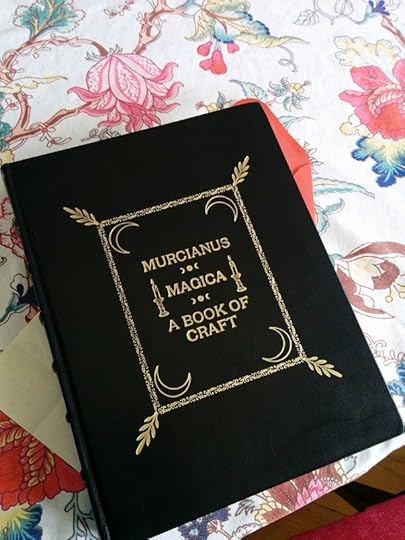
A handmade, leather-bound version of the book that weaves its way through Sourdough and Bitterwood. It is utterly exquisite.
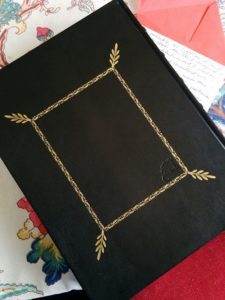
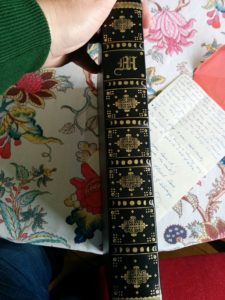
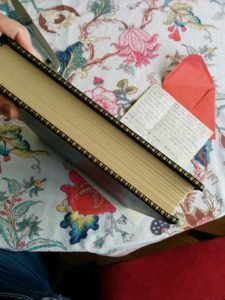

There is even on the back the mark, the “M”:
‘A grimoire. A book of craft. And this one …’ He finally picks the thing up and rubs his fingers on the back cover, in the right-hand bottom corner, finding what I already know is there: the subtle relief of an embossment. M. He almost drops the book, so great is his surprise. ‘Belonged to him!’
There were tears. Happy tears. My heart is so full.
Addendum: Beautiful Book of Beautifulness was created by the wonderful Nate McCall @mccall_company.
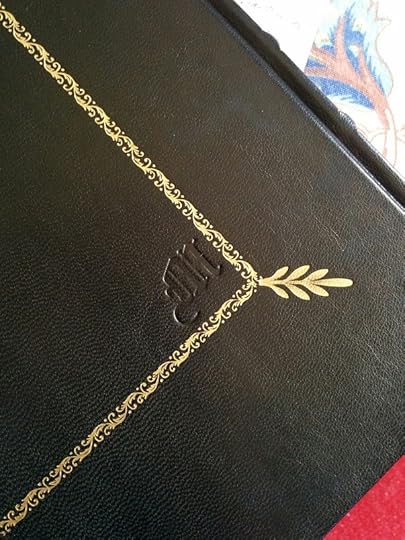
Good Places
 I’m mid-novel at the moment and that means my room (and large chunks of the house) are strewn with cairns of what might be mistaken for rubble, but are in fact the trail of things I’ve been considering one minute, taking in, then putting down as I go off to examine something else in the seemingly never-ending fugue of telling a story. Sucking in all the things, all the inspiration, all the ideas, putting them in the mental percolator – and in the process becoming a bit absent-minded (I wrote that as assbent-minded, so I rest my case).
I’m mid-novel at the moment and that means my room (and large chunks of the house) are strewn with cairns of what might be mistaken for rubble, but are in fact the trail of things I’ve been considering one minute, taking in, then putting down as I go off to examine something else in the seemingly never-ending fugue of telling a story. Sucking in all the things, all the inspiration, all the ideas, putting them in the mental percolator – and in the process becoming a bit absent-minded (I wrote that as assbent-minded, so I rest my case).
Stuff piles up. I forget to put stuff away. The dogs are under daily threat of an avalanche of clean-but-unfolded and definitely not-put-away clothes if they brush by the stacks too closely. I forget things I put “just over there” in the genuine belief I would be back in just one minute. The story pushes the other stuff out. The story becomes all. I am grateful for my ever-patient and beloved housemates who shrug and go “Ah, writer. What ya gonna do?”
One of the awesome things about this, however, is all the surprises you get when you find that stuff again. For instance, Aimée Lindorff gave me this adorable box for my birthday just over a month ago. I went through it then and thought it was wonderful, then said “I’ll examine it in more detail later”, coz we were in the middle of a dinner party with other friends and my rudeness does know some bounds.
And I put it on a shelf.
And yeah, you got it.
I forgot to go back for it.
But this morning as I fought my way past a skyscraper of washing, I spied it on the bookshelf. And I took it down. And I re-read all these gorgeous things. Thanks, Aims!!
And I am so overwhelmed with gratitude for all the people in my life, for their patience and kindness and support and their humour.
And for the fact that Aimée knows how much I love shiny things, so that this looks a wee bit like Oxford Street the day after Mardi Gras (slightly less sequins and fewer flaccid feathers).
And I have had another of those moments like the one a couple of months ago when I was cooking, waiting for the boys to come home, I had music playing, and I was having one of my rare indulgences in the Laphroaig bottle, and I just thought “I’m happy. Better yet, I’m content.” I was in a good place. I am in a good place.
Those moments have been rare.
But I recognise them when I get them, and I am grateful for them.
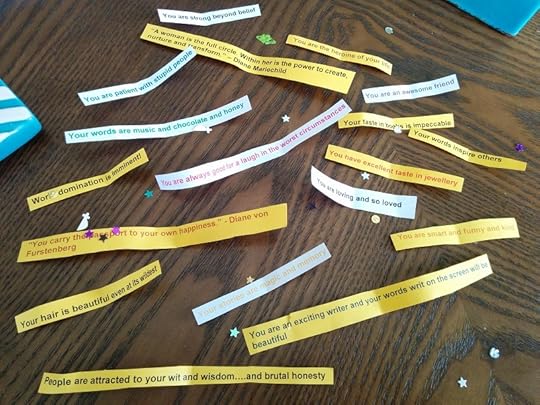
June 20, 2017
Shadows & Tall Trees #7: Robert Levy
 Robert Levy is an author of stories, screenplays and plays whose work has been seen Off-Broadway. A Harvard graduate subsequently trained as a forensic psychologist, his first novel The Glittering World was a finalist for both the Lambda Literary Award and the Shirley Jackson Award. Shorter work has appeared in magazines, journals, and anthologies like Black Static, Shadows & Tall Trees, Strange Aeons, Autumn Cthulhu, and The Brooklyn Quarterly, among others. A Brooklyn native, Robert is currently at work on a number of projects in various media including a television pilot, a scripted podcast, and a new novel. He can be found at TheRobertLevy.com.
Robert Levy is an author of stories, screenplays and plays whose work has been seen Off-Broadway. A Harvard graduate subsequently trained as a forensic psychologist, his first novel The Glittering World was a finalist for both the Lambda Literary Award and the Shirley Jackson Award. Shorter work has appeared in magazines, journals, and anthologies like Black Static, Shadows & Tall Trees, Strange Aeons, Autumn Cthulhu, and The Brooklyn Quarterly, among others. A Brooklyn native, Robert is currently at work on a number of projects in various media including a television pilot, a scripted podcast, and a new novel. He can be found at TheRobertLevy.com.
1. What inspired your story in Shadows & Tall Trees 7?
Over the same weekend, my great-aunt and great-uncle (my grandmother’s sister and her brother-in-law) died two days apart from each other. Due to the close timing, as well as various mourning customs, our family had two separate viewings, two separate burials, and two separate wakes, all at the same locations but spread over the course of a week. This occurred amidst a frigid and epic blizzard that blanketed New York and the cemetery, complicating everything from the service to the actual burial arrangements; we could barely make it to the gravesite. Needless to say, death and snow both weighed heavily on my mind.
I’m also a big fan of Mahalia Jackson, and one day I had her song “In the Upper Room” in my head, which I’ve loved since high school. It struck me that I actually didn’t know what the upper room referred to, so I looked it up and discovered it’s the room where the Last Supper took place. Another name for the upper room is the cenacle, and a secondary meaning of cenacle is a small group or clique. The dual meaning of this word, coupled with the aforementioned personal background, provided me with the main ingredients for my less-than-wholesome stew.
2. Can you recall the first story you ever read that made you think “I want to be a writer!”?
No, but I can remember the first novel that made me think I wanted to be a novelist, which was VELOCITY by Kristin McCloy. For years during high school and college I wrote almost exclusively in first-person/present-tense in homage and imitation of that novel (and sometimes still do)!
3. What scares you?
Lawlessness. Amorality. Total physical paralysis.
4. You can take five books to a desert island: which ones do you choose?
The Bible, The Collected Works of HP Lovecraft, two comprehensive manuals on survivalism, and In Search of Lost Time, aka Remembrance of Things Past (which I’ve never read but it seems like a good occasion).
5. What’s next for you? 
Working on a novel, a few stories, a screenplay, a scripted podcast, and a television pilot. Oh, and figuring out how to build a fire in case I’m ever stranded on a desert island. Hopefully I won’t have to burn the Proust.
June 19, 2017
Hypothermia, Healing and Hallucinatory Polar Bears

As it is today, overcast and cold.
Those of you who know me well will be very aware that I hate exercise – possibly because I have on more than one occasion screamed “I hate exercise!” I’m subtle like that. In the cold dark hours of the night I have been known to yell at Walter the Fitbit “You’re a liar! A filthy, filthy liar!” When my beloved sister talks about the sport she is watching, my eyes roll back so far in my head that I can hear rattling and I enter the Coma Zone.
I loathe it, it hurts, there’s sweat and stretchy fabrics involved, and I consider it a punishment for having eaten. I know I am not alone in this BUT I also know that I’m not necessarily right.
Keep in mind that two of my girlfriends are the fittest people I know. I love them, I adore their enthusiasm, I would do anything for them – but this in no way detracts from the fact that I also occasionally want to set fire to them and see how long it will take the lycra™ to melt. Rest assured that I WILL NOT DO THIS.
I’m self-aware enough to know that this is absolutely nothing to do with them. This is nothing to do with our friendships or the depth of feeling and respect I have for them. It’s all to do with my personal malfunctions formed in childhood. Being forced to play sport when you’re a pudgy klutzy kid with no hand-eye co-ordination who rather be reading a book? Better yet, make it competitive sport, so everyone can see you fuck up and fail. I know my parents were trying to do the right thing (it’s okay, Mum, I don’t blame you, I won’t write a tell-all book about it), to ensure my health and well-being; I know they struggled with having a kid who did not want to DO THE SPORTING, who was not like the other children.
So, self-awareness notwithstanding, I cannot foresee a time in my life when I will decide I love exercise. However, I’m also aware that a decrepit old age is not to be looked forward to, that there are changes I need to make in order to avoid that. Change is hard. I’ve always tried to be adaptable because I know that staying the same is not always healthy. But change is really freaking hard.
Those of you who know me really, really well, will also be aware that my 2016 was a weird mix of astonishing personal tyre fire and career huzzahs. While Vigil was launched and did really well, I broke up with my long-term partner, I tore the meniscus in my right knee, then messed up the left knee just so the other one wouldn’t feel so lonely, two family members were diagnosed with cancer, the death of another, I had to schlep around the UK for four weeks using a cane (and the UK is not disability-friendly), then return home and pack up the last six years of my life and move. I had to put the majority of my books in storage, which felt like the final heartbreak. 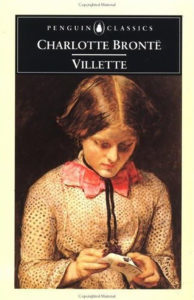
Now, before you judge me on my priorities, consider this: those books have been my solace for a really long time. Some of them have been with me since I was very small; they’re my oldest friends, they carry memories of love in them. I remember who gave them to me, who I was with when I read them: my battered copy of Heyer’s These Old Shades came from the hand of my Gran Slatter; the Heritage of Britain book was a Christmas gift from my parents when I was sixteen, and I dreamed over that book for so very long; my copy of Clive Barker’s Cabal came from my sister – a replacement for the one she loaned to a boyfriend many years ago who did not return it (the motherfudger). My copy of Villette came from my friend Lisa Robinson when we were in Israel and my heart was broken; the book was hers, she’d not wandered out into the Negev to find a bookstore, she’d given me a book that had given her comfort when she was heartbroken – this book carries love and pain and comfort with it. I re-read it once a year, I have given copies to friends who needed it (although not this copy); sometimes when I open its pages I imagine that sand falls out, that the golden days in the desert are somehow still embedded within. It’s on my shelf, the cover was clawed by my sister’s cat, the book is battered, but it’s one that I did not put in storage. It’s one that came with me – just as I will NEVER set my superfit GFs on fire, I’ll never leave this book behind.
My books are my memories, they’ve been a refuge from many things (not just sport). They were my teachers, they held and still hold new worlds. They’re my past and contain fragments and hints of my future; they are part of who I am today and who I will become.
“Where is this all going?” I can hear you ask. “Are we already in the bit about hallucinations? Is this contagious?”
Yeah, probably, but there is a point to this. At least, I think there is.
I haven’t been in the pool for about six weeks because it’s cold. Yes, I know it’s only a Brisbane winter, there’s no ice and snow, but I am accustomed to a certain degree of warmth in my watery elements, and that is not currently present in the pool. Getting to a heated pool is time-consuming and annoyance-causing. But because I’ve not been in the pool, not doing my exercises, the knees and back and hips have been aching. So, I’ve been looking longingly at the body of water in the back yard, trying to psych myself up – a process that sometimes involves thoughts about buying wetsuits, which generally then downgrade to “I wonder if I could wear a tracksuit in there?”
But the other day a friend said, “Just jump in. You’ll feel better.”
It was simple, really.
Just jump in.
So I did.
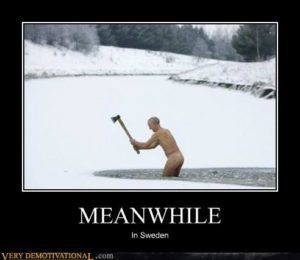
Thanks, Maria Haskins
And it was fucking freezing.
I will admit that the first five minutes were devoted to cursing his name, plotting revenge and thinking that I would be speed-dialling the flying monkeys and sending them to his house the moment I got out of the water.
Yet somewhere between thoughts, between “I think my breasts have frozen off” and “A polar bear is chasing me, I must swim for my life”, I found a sweet spot of about 30 minutes. And in that 30 minutes, there is a quiet place, there is zen, there is the comfort and vaguely masochistic pleasure of the burn in my muscles because it’s the only warmth anywhere in that goddamned swimming pool. But there is also definitely “better”. I’m on day three of this: I feel better, my mind is clearer, my aches and pains are not gone but are falling away. I swim until there is no longer that burn in my muscles; I swim until the creature I like to call “Hypothermia the Hallucinatory Polar Bear” turns up at my shoulder and says “Hey, kid? It’s time. No, really. It’s time, you’re not meant to be this shade of blue.”
I resist the impulse to shout “You’re not my real mum!” and I get out of the water.
For me, the pool is not just about the physical activity. It’s the quiet space where the mind can rest, can sort out all the shitty spaghetti of life, the tangled wool of emotions and expectations and fears and insecurities (“My book will fail! I’ll have to go back to an office job!” “No one will ever love me again!” “I broke a nail!” “WTF is up with my hair?!” “I will never solve this plot problem!” “INSERT GENERAL FIRST WORLD HOWL HERE.”). It’s calm and I can manage everything there because there’s nothing else I can do except move my arms and legs and concentrate on not freezing.
I can do it there because there’s just the sound of the water and it’s primal. In The Silence of the Lambs, Thomas Harris wrote a scene where Ardelia Mapp finds Clarice Starling asleep in the laundry, curled up against the washing machine: “… yet it was Mapp who knew that the washing machine’s rhythm was like a great heartbeat and the rush of its waters was what the unborn hear – our last memory of peace.”
I love it. It is simple and it is true. And this is what I love about writing, about those who can shape words to shape our hearts, to shift our minds, to make us better people, to show us our darknesses but also a path to the light. To make us brave. To make us just jump in.
There’s a storage shed down the road with a lot of my old life in it. There are still a few boxes here in the house that I will soon clean out, if only so I can make a fort. And while there are things I will eventually keep from that old life, there is much I will let go.
Just jump in.
Bookiversary
A year ago these lovely things arrived on my doorstep, the culmination of five years working on Vigil, and thirteen years on the craft of writing.

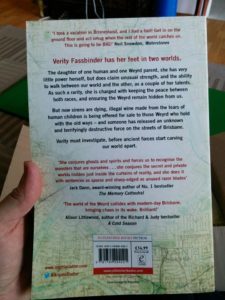
June 13, 2017
Solace & Grief: Foz Meadows
 Foz Meadows is an Australian fantasy author, reviewer, poet and blogger. She has most recently published An Accident of Stars, an epic portal fantasy from Angry Robot, and Coral Bones, a Shakespearean novella; she has also written two YA urban fantasy novels, Solace and Grief and The Key to Starveldt. A full list of her publications can be found here. Foz is a reviewer for Strange Horizons and a contributing writer for The Huffington Post and Black Gate; her essays have appeared in various venues online, including The Mary Sue, A Dribble Of Ink and The Book Smugglers. In 2014 she was nominated for a Hugo Award for Best Fan Writer; she has also been nominated for the Ditmar for Best Fan Writer in 2014 and 2016. Foz likes cheese, geekery, writing, webcomics and general weirdness. Dislikes include Hollywood rom-coms, liquorice and waking up.
Foz Meadows is an Australian fantasy author, reviewer, poet and blogger. She has most recently published An Accident of Stars, an epic portal fantasy from Angry Robot, and Coral Bones, a Shakespearean novella; she has also written two YA urban fantasy novels, Solace and Grief and The Key to Starveldt. A full list of her publications can be found here. Foz is a reviewer for Strange Horizons and a contributing writer for The Huffington Post and Black Gate; her essays have appeared in various venues online, including The Mary Sue, A Dribble Of Ink and The Book Smugglers. In 2014 she was nominated for a Hugo Award for Best Fan Writer; she has also been nominated for the Ditmar for Best Fan Writer in 2014 and 2016. Foz likes cheese, geekery, writing, webcomics and general weirdness. Dislikes include Hollywood rom-coms, liquorice and waking up.
Foz currently lives in Brisbane with not enough books, her very own philosopher and a toddler. Surprisingly, this is a good thing.
1. So what should new readers know about Foz Meadows?
I’m a genderqueer dork who yells a lot online about fandom, feelings, feminism and politics, not necessarily in that order; I also write poetry, reviews, essays, short stories and fantasy novels. In any social gathering, you will find me lurking in close proximity to both food and alcohol, unless the venue in question has a resident cat (or cats), in which case I’ll be trying to befriend them. I think that characterisation and worldbuilding are the lynchpins of a good plot, that SFF is valuable precisely because it shows us how to create new worlds, and that tropes are both a feature and a bug. Also, I love karaoke.
2. Name five people you’d like to invite to dinner. 
See, that’s a tricky question to answer, because while I’m probably meant to choose an ideal guest-list from the untouchable famous – or maybe from all of history – that’s honestly too much pressure. I’m much more fond of informal hangouts than actual sit-down dinners, and I’d feel too self-conscious to try and have Important People sitting on my toddler-stained Ikea couch eating Bolognese out of my favourite white bowls with the fish painted on, you know? Plus, I mean, if you start picking people from different historical periods, it sounds all fun on paper, but in reality, there’d be so many cultural and language barriers that even at a fancy catered venue, it would end up super awkward. So honestly, if I had the ability to magic five people of my choosing over to my place for dinner, it’d just be a bunch of my real-world friends who live so far away that I don’t get to see them often, let alone all at once. That’d be amazing.
3. When you’re in the mood to read, who is your first choice?
Again, a difficult question! At this point, my TBR pile stretches into infinity, and if I’ve got the brainpower to start a new book, I usually go for whatever recent release or as-yet unread purchase is closest to the top of the stack. If I want a comfort read, though, my current go-to is The Goblin Emperor, by Katherine Addison, though Tamora Pierce’s Protector of the Small quartet is also high up the list.
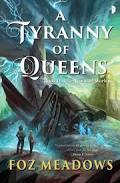 4. What was the story/book that made you think “I want to write!”?
4. What was the story/book that made you think “I want to write!”?
For me, it was less a single book or author that made me want to write, and more the love I felt for stories generally. I grew up in a house full of books, and as a kid, it never really occurred to me not to try my hand at it. We had to do plenty of creative writing assignments in primary school, which led in pretty naturally to me writing my own stories at home, for fun. The first time I ever sat down with the express intention of producing a novel, I was eleven or so, and my direct inspiration was Elyne Mitchell’s Silver Brumby series – I tried to write my own story about the lives of wild horses, and while I didn’t get very far with it, that’s when I realised that writing was something I wanted to do, not just for my own pleasure, but as a career.
5. What was the inspiration for Solace and Grief? 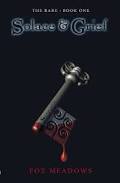
Way back in 2006-2007, I’d started sending out the Great Unpublished Epic (GUE) that I worked on all through high school and university. By that point, I’d been editing it for so long that my brain just wanted a break, and as it happened, I found myself re-bingeing Buffy the Vampire Slayer while working a job as a legal PA. Like many administrative positions, the job was either full-on busy or dead quiet, and during one of the quiet periods, I started mulling over the (largely inconsistent) mythology in Buffy and thought, why not write my own take on magic and vampires and urban fantasy? I honestly didn’t expect it to go anywhere, which is perhaps why it did: free of any personal pressure or expectations, the first draft of the novel only took a few months to finish, and when I started submitting it alongside the GUE, it was Solace & Grief that people were interested in.
6. Do you prefer writing short or long form?
I wouldn’t call it a preference, per se, but most of what I end up producing – or finishing, rather – tends towards novel-length. My drafts folder is full of unfinished short stories: I get plenty of ideas that work as shorts, but for some reason, I find it really difficult to go back and complete them once the initial surge of enthusiasm has passed. With novels, it’s easier to take my time, to write in bouts interspersed with breaks as I work out the kinks and characterisation, but short stories are different. Unless I finish them all in one sitting – or, rarely, two – the likelihood is that I won’t finish them at all. Or at least, that’s been my habit so far: I’ve recently started trying to write the initial idea down as notes, so that I can mull the execution and come back to it later, but whether or not that’ll work long-term is yet to be established.
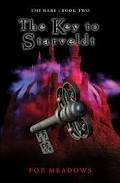 7. Who’s your favourite heroine? Your favourite villain?
7. Who’s your favourite heroine? Your favourite villain?
I’m terrible at picking overall favourites of any kind, because it always feels like comparing apples to oranges. I love Nausicaa from Nausicaa of the Valley of the Wind, but measuring her against Dutch from Killjoys or Keladry of Mindelan is kind of impossible, not only because they all come from different SFFnal subgenres, but because they exist in different types of narrative. The same applies to villains, with the added complication that there’s a difference between enjoying an evil but well-written villain and actually liking the character despite their wicked ways. Mads Mikklesen as Hannibal in the recent TV series has a fascinating tendency to blur the lines between the two; it’s just such an amazing performance that, even when you’re horrified, he’s still compelling. But trying to compare him to Cersei Lannister or No-Face from Spirited Away is… not really possible.
8. What is the book that taught you the most about writing?
In absolute honesty, and as much as I’ve learned something from every book I’ve written, the thing that’s taught me the most about writing is fanfiction. In traditional publishing, there’s such a long stretch of time between creation, submission, editing and publication that it’s easy to get lost in the process. I’ve said before that the paradoxical thing about writing a book is that the act of completing it turns you into someone who couldn’t have written it, because who you are at the end is, in some fundamental way, different to who you were at the outset. So when the editing process stretches out over months or years – when you go so long without external feedback, caught up in second-guessing yourself because the person you are now, doing final copyedits, isn’t who you were when you wrote the first draft, and how do you reconcile the two? – it’s easy to feel like you’re somehow a step removed from your own creation. But fanfiction has this glorious, raw immediacy to it, not just in terms of stylistic conventions, but the rate of production and the speed of feedback. You write a chapter, you post a chapter, and ten minutes later you’ve got commenters telling you what they thought and asking for the next one. Fanfiction taught me how to get out of my own damn head and just write the thing; how to break conventions and fix issues on the fly and just generally produce stuff that was better, faster and less self-conscious. I’m an infinitely better writer for having become involved with fanfiction than I was before, and I can’t recommend it highly enough. Plus and also: queer everything.
9. Who were/are your literary influences? 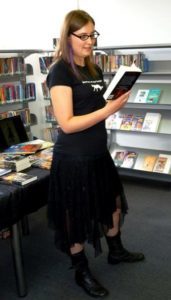
In approximate order of appearance, my most influential authors growing up were Rudyard Kipling, Geoffrey McSkimming, Brian Jacques, Tamora Pierce, Douglass Adams, Sara Douglass, Anne McCaffrey, Terry Pratchett, Robin Hobb, Katharine Kerr, Kate Elliott and Neil Gaiman. There are other authors I’ve discovered since then who’ve had a huge impact on how I view SFF as an adult – notably N.K. Jemisin, Catherynne M. Valente, Lois McMaster Bujold, Aliette de Bodard and Nick Harkaway – but those first twelve are my core genealogy. Their works are the line of direct descent I trace whenever I’m asked how I discovered this part of genre or that, like a sort of developmental zodiac. I’m more critical of all their works now than I was growing up, but I wouldn’t be here without them, and for that, I’m grateful.
10. What’s next for Foz Meadows?
Right now, I’m working on a couple of queer epic fantasy romances that I’m really excited about, but I’d also like to do some more with the Manifold Worlds series – perhaps not another novel right off, but maybe a novella or two. I’ll have to play with it all and find out!
June 6, 2017
Mad Hatters and March Hares
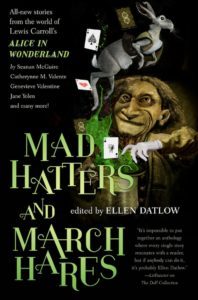 And this new anthology from Ellen Datlow is up for pre-order, Mad Hatters and March Hares: All-New Stories from the World of Lewis Carroll’s Alice in Wonderland.
And this new anthology from Ellen Datlow is up for pre-order, Mad Hatters and March Hares: All-New Stories from the World of Lewis Carroll’s Alice in Wonderland.
Gentle Alice – Kris Dikeman (poem)
My Own Invention – Delia Sherman
Lily-White & The Thief of Lesser Night – C.S.E. Cooney
Conjoined – Jane Yolen
Mercury – Priya Sharma
Some Kind of Wonderland – Richard Bowes
Alis – Stephen Graham Jones
All the King’s Men – Jeffrey Ford
Run, Rabbit – Angela Slatter
In Memory of a Summer’s Day – Matthew Kressel
Sentence Like a Saturday – Seanan McGuire
Worrity, Worrity – Andy Duncan
Eating the Alice Cake – Kaaron Warren
The Queen of Hats – Ysabeau Wilce
A Comfort, One Way – Genevieve Valentine
The Flame After the Candle – Catherynne M. Valente
Moon, Memory, Muchness – Katherine Vaz
Run, Rabbit, Run – Jane Yolen (poem)
Shadows & Tall Trees #7: Christopher Slatsky
 Christopher Slatsky’s stories have appeared in The Year’s Best Weird Fiction vol. 3, the Lovecraft eZine, Nightscript vol. 2, and elsewhere. His debut collection Alectryomancer and Other Weird Tales (Dunhams Manor Press) was released summer of 2015. He currently resides in Southern California.
Christopher Slatsky’s stories have appeared in The Year’s Best Weird Fiction vol. 3, the Lovecraft eZine, Nightscript vol. 2, and elsewhere. His debut collection Alectryomancer and Other Weird Tales (Dunhams Manor Press) was released summer of 2015. He currently resides in Southern California.
1. What inspired your story in Shadows & Tall Trees 7?
As clichéd as it may be, my story was based on a dream about my (long deceased) grandparent’s home. That and the anxiety parents and children all too often have over failing to adequately communicate their goodbyes was the impetus.
2. Can you recall the first story you ever read that made you think “I want to be a writer!”?
The earliest story that sparked the writing bug would have to be Poe’s “The Black Cat”. There was something more to it than the gruesome crime as depicted, something profoundly uncanny in the dread-soaked atmosphere.
3. What scares you?
Not much. The universe will inevitably collapse and decay, the metabolic tantrum that makes me an organic automaton will continue for a few more decades hopefully. No phobias, no ghosts, no gods, no supernatural antagonists to afflict me. I do have tremendous anxiety over the well being of my wife and children. That fear is omnipresent.
4. You can take five books to a desert island: which ones do you choose? 
Of course I’ll change my mind once I set foot on the island, but here goes: You Will Never See Any God (Krause), Giovanni’s Room (Baldwin), The Invisible Man (Ellison), Blood Meridian (McCarthy), and City of Woman (Landes).
5. What’s next for you?
Besides my story in Shadows and Tall Trees v. 7, I have others awaiting publication in Darker Companions, Would But Time Await: An Anthology of New England Folk Horror, and Looming Low.



